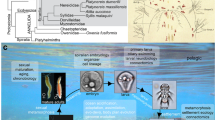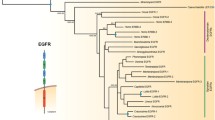Abstract
Tyrosine depletion in metazoan proteins was recently explained to be due to the appearance of tyrosine kinases in Metazoa. Here, we present a complementary explanation for the depletion of tyrosine, stating the importance of tyrosine in signaling not only as a phosphorylation target but also as a precursor for catecholamines and hormones. Molecules (dopamine, norepinephrine, and epinephrine, and to a lesser extent serotonin and melatonin) critical to metazoan multicellular signaling are also greatly dependent on a supply of tyrosine. These signaling molecules are synthesized in two highly linked pathways specific to metazoans. In addition, the shikimate pathway that non-metazoans use to synthesize the aromatic amino acids is not present in metazoans. These important pathway changes have occurred between Metazoa and other eukaryotes, causing significant changes to tyrosine metabolism and rendering tyrosine crucial for extracellular signaling. In addition, the evolutionary and functional linkage between these two pathways and the resulting implications for neuropathology are discussed.



Similar content being viewed by others
References
Baade PD, Fritschi L, Freedman DM (2007) Mortality due to amyotrophic lateral sclerosis and Parkinson’s disease among melanoma patients. Neuroepidemiology 28:16–20
Barbas D, DesGroseillers L, Castellucci VF et al (2003) Multiple serotonergic mechanisms contributing to sensitization in aplysia: evidence of diverse serotonin receptor subtypes. Learn Mem 10:373–386
Blenau W, Baumann A (2001) Molecular and pharmacological properties of insect biogenic amine receptors: lessons from Drosophila melanogaster and Apis mellifera. Arch Insect Biochem Physiol 48:13–38
Cao J, Shi F, Liu X et al (2010) Phylogenetic analysis and evolution of aromatic amino acid hydroxylase. FEBS Lett 584:4775–4782
Coon SL, Bégay V, Deurloo D et al (1999) Two arylalkylamine N-acetyltransferase genes mediate melatonin synthesis in fish. J Biol Chem 274:9076–9082
Darriba D, Taboada GL, Doallo R, Posada D (2011) ProtTest 3: fast selection of best-fit models of protein evolution. Bioinformatics 27:1164–1165
Fitzgerald LM, Szmant AM (1997) Biosynthesis of “essential” amino acids by scleractinian corals. Biochem J 322(Pt 1):213–221
Fitzpatrick PF (1999) Tetrahydropterin-dependent amino acid hydroxylases. Annu Rev Biochem 68:355–381
Freedman DM, Travis LB, Gridley G, Kuncl RW (2005) Amyotrophic lateral sclerosis mortality in 1.9 million US cancer survivors. Neuroepidemiology 25:176–180
Fujiwara T, Maisonneuve S, Isshiki M et al (2010) Sekiguchi lesion gene encodes a cytochrome P450 monooxygenase that catalyzes conversion of tryptamine to serotonin in rice. J Biol Chem 285:11308–11313
Gatellier L, Nagao T, Kanzaki R (2004) Serotonin modifies the sensitivity of the male silkmoth to pheromone. J Exp Biol 207:2487–2496
Gudbjartsson DF, Sulem P, Stacey SN et al (2008) ASIP and TYR pigmentation variants associate with cutaneous melanoma and basal cell carcinoma. Nat Genet 40:886–891
Guindon S, Lethiec F, Duroux P, Gascuel O (2005) PHYML online—a web server for fast maximum likelihood-based phylogenetic inference. Nucleic Acids Res 33:W557–W559
Haavik J, Blau N, Thöny B (2008) Mutations in human monoamine-related neurotransmitter pathway genes. Hum Mutat 29:891–902
Hardeland R, Cardinali DP, Srinivasan V et al (2011) Melatonin–a pleiotropic, orchestrating regulator molecule. Prog Neurobiol 93:350–384
Hedges SB, Dudley J, Kumar S (2006) TimeTree: a public knowledge-base of divergence times among organisms. Bioinformatics 22:2971–2972
Herrmann KM, Weaver LM (1999) The Shikimate pathway. Annu Rev Plant Physiol Plant Mol Biol 50:473–503
Holton TA, Pisani D (2010) Deep genomic-scale analyses of the metazoa reject Coelomata: evidence from single- and multigene families analyzed under a supertree and supermatrix paradigm. Genome Biol Evol 2:310–324
Ishihara A, Hashimoto Y, Tanaka C et al (2008) The tryptophan pathway is involved in the defense responses of rice against pathogenic infection via serotonin production. Plant J Cell Mol Biol 54:481–495
Iyer LM, Aravind L, Coon SL et al (2004) Evolution of cell–cell signaling in animals: did late horizontal gene transfer from bacteria have a role? Trends Genet 20:292–299
Kanehisa M, Goto S (2000) KEGG: kyoto encyclopedia of genes and genomes. Nucleic Acids Res 28:27–30
Kanehisa M, Goto S, Sato Y et al (2012) KEGG for integration and interpretation of large-scale molecular data sets. Nucleic Acids Res 40:D109–D114
Katoh K, Misawa K, Kuma K, Miyata T (2002) MAFFT: a novel method for rapid multiple sequence alignment based on fast Fourier transform. Nucleic Acids Res 30:3059–3066
Koon AC, Ashley J, Barria R et al (2011) Autoregulatory and paracrine control of synaptic and behavioral plasticity by octopaminergic signaling. Nat Neurosci 14:190–199
Lange AB (2009) Tyramine: from octopamine precursor to neuroactive chemical in insects. Gen Comparative Endocrinol 162:18–26
Mann MB, Wu S, Rostamkhani M et al (2001) Phenylethanolamine N-methyltransferase (PNMT) gene and early-onset Alzheimer disease. Am J Med Genet 105:312–316
Mann MB, Wu S, Rostamkhani M et al (2002) Association between the phenylethanolamine N-methyltransferase gene and multiple sclerosis. J Neuroimmunol 124:101–105
Nan H, Kraft P, Hunter DJ, Han J (2009) Genetic variants in pigmentation genes, pigmentary phenotypes, and risk of skin cancer in Caucasians. Int J Cancer 125:909–917
Roeder T (1999) Octopamine in invertebrates. Prog Neurobiol 59:533–561
Scheiner R, Baumann A, Blenau W (2006) Aminergic control and modulation of honeybee behaviour. Curr Neuropharmacol 4:259–276
Schwaerzel M, Monastirioti M, Scholz H et al (2003) Dopamine and octopamine differentiate between aversive and appetitive olfactory memories in Drosophila. J Neurosci Off J Soc Neurosci 23:10495–10502
Setini A, Pierucci F, Senatori O, Nicotra A (2005) Molecular characterization of monoamine oxidase in zebrafish (Danio rerio). Comp Biochem Physiol B Biochem Mol Biol 140:153–161
Siltberg-Liberles J, Steen IH, Svebak RM, Martinez A (2008) The phylogeny of the aromatic amino acid hydroxylases revisited by characterizing phenylalanine hydroxylase from Dictyostelium discoideum. Gene 427:86–92
Starcevic A, Akthar S, Dunlap WC et al (2008) Enzymes of the shikimic acid pathway encoded in the genome of a basal metazoan, Nematostella vectensis, have microbial origins. Proc Natl Acad Sci USA 105:2533–2537
Su Z, Huang W, Gu X (2011) Comment on positive selection of tyrosine loss in metazoan evolution. Science 332:917 author reply 917
Tan CSH, Pasculescu A, Lim WA et al (2009) Positive selection of tyrosine loss in metazoan evolution. Science 325:1686–1688
Tan D-X, Hardeland R, Manchester LC et al (2012) Functional roles of melatonin in plants, and perspectives in nutritional and agricultural science. J Exp Bot 63:577–597
Thöny B, Auerbach G, Blau N (2000) Tetrahydrobiopterin biosynthesis, regeneration and functions. Biochem J 347(Pt 1):1–16
Walther DJ, Peter J-U, Bashammakh S et al (2003) Synthesis of serotonin by a second tryptophan hydroxylase isoform. Science 299:76
Wells DG, Bjorksten AR (1989) Monoamine oxidase inhibitors revisited. Can J Anaesth J canadien d’anesthésie 36:64–74
Xin X, Mains RE, Eipper BA (2004) Monooxygenase X, a member of the copper-dependent monooxygenase family localized to the endoplasmic reticulum. J Biol Chem 279:48159–48167
Acknowledgments
Special thanks to John Horner for assistance with manuscript preparation. This work was supported by Award Number P20RR016474 from the National Center for Research Resources. The content is solely the responsibility of the authors and does not necessarily represent the official views of the National Center for Research Resources or the National Institutes of Health.
Conflict of interest
The authors declare that they have no conflict of interest.
Author information
Authors and Affiliations
Corresponding author
Electronic supplementary material
Below is the link to the electronic supplementary material.
Rights and permissions
About this article
Cite this article
Kutchko, K.M., Siltberg-Liberles, J. Metazoan innovation: from aromatic amino acids to extracellular signaling. Amino Acids 45, 359–367 (2013). https://doi.org/10.1007/s00726-013-1509-x
Received:
Accepted:
Published:
Issue Date:
DOI: https://doi.org/10.1007/s00726-013-1509-x




